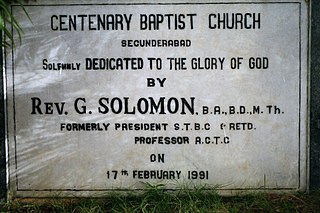P. Solomon Raj, AELC | |
|---|---|
 | |
| Born | Pulidindi Solomon Raj February 21, 1921 [1] |
| Died | December 28, 2019 (aged 98) Vijayawada, Krishna District (Andhra Pradesh, India) |
| Nationality | Indian |
| Education | |
| Alma mater | |
| Occupation | Pastor |
| Years active | 1947 - 2019 (72 years) |
| Known for | Christian art on Batik |
| Religion | Christianity |
| Church | Andhra Evangelical Lutheran Church Society |
| Ordained | 1956 [3] |
| Writings | See section |
Congregations served | Andhra Evangelical Lutheran Church Society [3] |
Offices held | Director, Suvartha Vani, Vijayawada [3] |
| Title | The Reverend Doctor |
P. Solomon Raj(21 February 1921 [1] - 28 December 2019) was a pastor of Protestant Andhra Evangelical Lutheran Church Society headquartered in Guntur with major contribution to theological research and arts. [4] Old Testament scholar Victor Premasagar wrote about Raj as a pastor, professor of communications, creative artist, sculptor, poet and a theological writer. [5]
Contents
- Early education and studies
- Graduate studies
- Post-graduate studies
- Doctoral studies
- Art student
- Career
- Pastor
- Administrator
- Professor
- Contribution
- Writings
- Arts
- Scholarly appraisal
- Recognition and honours
- References
- Further reading
Church historian, K. L. Richardson of the Andhra Christian Theological College, Hyderabad, India, in Towards Self-Reliance: A historical survey of the programmes and efforts of Andhra Evangelical Lutheran Church from 1927 to 1969 [6] has highlighted the contribution of Raj with special reference to Indian liturgy and music. Richardson writes,
(Adapted) During 1960s, Rev. P. Solomon Raju contributed very much to the AELC on indigenous methods through his writings, seminars and other special efforts. Many Christian plays, Burra kathas and Hari Kathas were written in Telugu by the distinguished writers and musicians including Solomon Raj.
Much like theologians of India believing in the Indian ethos akin to A. B. Masilamani, D. S. Amalorpavadass, Victor Premasagar, M. Victor Paul and others, Raj believes that it is only that form of Christianity, deeply etched in diverse cultures of India, that can influence Christianity in India. While A. B. Masilamani promoted Indian liturgy in the Christian Hymnal in Telugu, D. S. Amalorpavadass advocated for vernacular liturgy. Similarly, Victor Premasagar had recognised the contribution of indigenous movements. [5] M. Victor Paul rooted for indigenous churches in place of institutionalized ones. It is in such a setting that Raj's contribution gains credence in the light of his doctoral dissertation on the Bible Mission Movement by Father Devadas which Roger E. Hedlund writes as,
Solomon Raj shows that the traditional mission-founded Churches are really Western appendages. This is true of the Lutherans and other traditional denominations including the Church of South India and the Church of North India. Solomon Raj predicts that movements such as this one (Bible Mission of Fr. Devadas) will have an ever increasing influence upon Christianity in India. [7]
As an artist, Raj received global acclaim. Gudrun Löwner of the United Theological College, Bangalore has devoted a section in The Oxford Handbook of Christianity in Asia [8] ,
Still alive and creative is the Lutheran theologian and artist, Solomon Raj who uses batik and woodcuts, which use cheap materials that are readily available. He depicts Jesus amidst the refugees and suffering people. The artist's favourite story is John 4, where he shows the liberative message of Jesus taking water from an untouchable woman, something which is still distant reality in South Indian villages, where the Dalits are not allowed to take water from the wells of others since they are considered 'polluting'.




